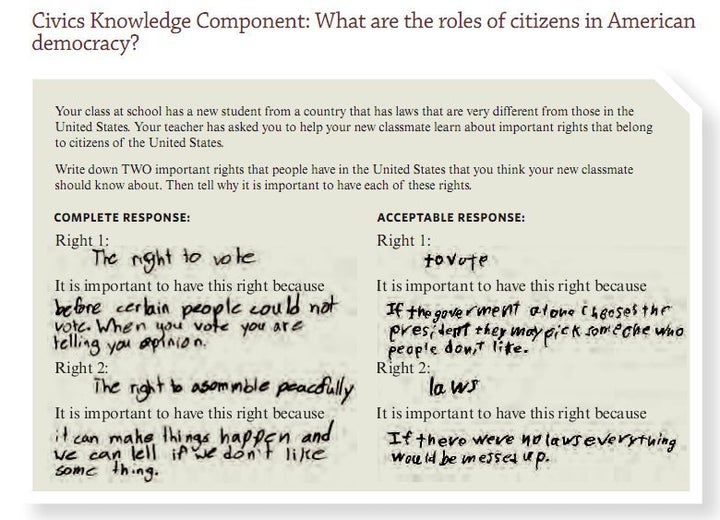
NEW YORK -- Can you name the three branches of the American government, their powers, and how other branches limit their powers? If so, you have a leg up on many U.S. eighth graders.
Only 7 percent of eighth graders could correctly identify the three branches of government on the civics portion of the 2010 National Assessment of Education Progress test to satisfy the grading standard of "complete." A further 10 percent of the sample group -- 9,600 eighth graders from 470 schools -- received a score of “acceptable” on the question, which asked students to fill out the chart describing the three branches' relationship to one another.
The 2010 NAEP results, released Wednesday, showed overall stagnation and low proficiency rates in civics.
“That’s pathetic,” former Supreme Court Justice Sandra Day O’Connor told The Huffington Post upon hearing the result of the branches of government question.
O’Connor has been active in promoting civics education, overseeing the creation of an educational website to address students’ lack of civic knowledge.
The NAEP report provides a snapshot of civics education in public and nonpublic schools in the fourth, eighth and 12th grades. The 2010 test assessed 26,600 students in a sample designed to be representative of the entire U.S. student population by race, socioeconomic status, education of parents, language barriers and disabilities.
NAEP tests are administered in several subjects -- including math, science, history and reading -- at different intervals. Students sat for the civics test in 1998, 2006 and 2010. According to Wednesday’s release, fourth grade scores increased slightly in 2010 from the previous years; eighth grade scores remained the same; and 12th grade scores dipped. Just one quarter of high-school seniors were deemed “proficient.”
“The statistics in this latest study confirm that we have a terrible problem on our hands,” O’Connor said. “It motivates me to work a lot harder."
Ted McConnell, Executive Director of the Campaign for the Civic Mission of School, said he saw the scores as a wake-up call. “We’re failing to educate the next generation in civic knowledge, civic skills and the disposition to participate,” he said.
McConnell added that he wasn’t surprised by the overall lack of improvement. “No Child Left Behind emphasizes a few subjects over all others,” he said, referring to the 2001 legislation that has resulted in an increase in testing in reading and math.
“Kids are being drilled to death in math and reading and, in some places, science,” he said. “It’s not leaving time to cover other topics as they should be covered.”
National Assessment Governing Board spokesman Stephaan Harris said funding for NAEP is determined by Congress’s budget allocations. NCLB has no influence over NAEP administration, Harris said, except in one area: “If a school system wants to receive Title I funds, they have to allow NAEP to come into their schools for reading and math.”
NAEP tests are used to track academic trends on a national level. The grades for science, math and reading tests are broken down by city or state, allowing district-by-district comparison. But the National Center for Education Statistics, which administers the NAEP, does not dis-aggregate the data for social studies exams, including the civics test.
According to NCES associate research scientist Grady Wilburn, that's because NAEP civics funding enables testing only among a small sample size -- one too limited to determine geographical trends.
But McConnell suggested that a spread of NAEP civics data across cities could encourage districts to promote lessons about the U.S. government. He said his group is lobbying for this data spread, and for a “competitive grant program to find the best civics teaching strategies and get them replicated.”
The test results should not be seen as dire in and of themselves, cautioned Peter Levine, director of Center for Information & Research on Civic Learning & Engagement at Tufts University. He sat on the board that designed the NAEP civics exam. “It’s not a perfect test. It’s a test of academic skills related to civics,” he said, adding that it would be difficult for many adults to succeed on the test.
Concern about youth engagement in civics and voting, Levine said, should extend beyond low test scores. “America has always relied on active citizens to solve our most serious problems,” he said. “If the next generation of kids can’t rise to that challenge, we’ll be in trouble.”
Here are some other trends in the report:
- The achievement gap in civics in the eighth and 12th grades is narrowing among Latino learners.
- Fourth grade female students scored higher than their male counterparts: the gap between female and male students increased from two points to seven points.
- Only 2 percent of fourth graders, 1 percent of eighth graders and 4 percent of 12th graders were determined to be “advanced” in civics.
- As The New York Times noted, only half of eighth graders tested could explain the purpose of the Bill of Rights.
Harris said results for US history and geography tests will be released during the summer.